Article and all photos by Joe Mock, BaseballParks.com
All rights reserved
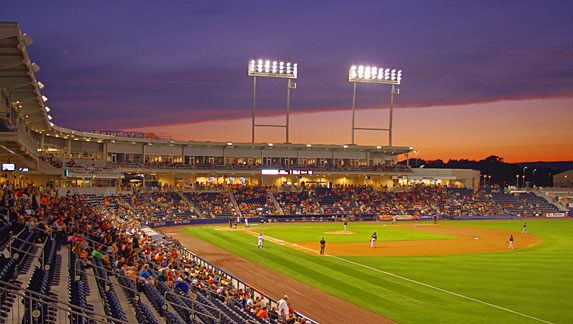 |
When was the last time you heard of a company selling off a division, then turning around and building that sold-off entity a brand-new facility?
Consider the case of Lackawanna County, Pennsylvania. They owned the Triple-A franchise that played within its borders, but as the team’s ballpark showed its age as it approached its 20th birthday, the County lacked the funds to build the new stadium that they needed. So what did the County Commissioners elect to do? Sell the team, then take the money from the sale and build that team the new park.
| Ballpark Stats |
| Team: Scranton/Wilkes-Barre RailRiders of the Triple-A International League |
| First regular-season game: April 4, 2013, an 8-4 loss to Pawtucket |
| Capacity: 7,500 fixed seats, room for 2,500 general admission |
| Architect: EwingCole |
| Construction: Alvin H. Butz, Inc. |
| Price: $33.8 million for construction. Total project cost was $43.3 million |
| Home dugout: 3B side |
| Field points: northeast, right into a hillside |
| Playing surface: blend of three Kentucky bluegrasses |
| Ticket price range: From $7 berm ticket to $12 Infield Box |
| Betcha didn’t know: Demolition of a light tower was delayed three weeks after a nest with newborn falcons was discovered |
While a commercial company would never consider such an action, it made sense for a county government to do so. Let’s look at the history of pro baseball in this area to explain how this came to be.
The city of Wilkes-Barre, the county seat of Luzerne County, had a pro baseball team most years during the first half of the twentieth century. They were known as the Barons except for three seasons when they were the Indians. They played in the New York-Penn League until 1937 (Hall Of Fame manager Joe McCarthy was the team’s skipper for three seasons), until the league became known as the Eastern League in 1938. Except for four seasons when there was no team in Wilkes-Barre, they played in the EL until the franchise moved to Johnstown, PA mid-season in 1955.
Twenty miles to the northeast, the city of Scranton had its own team in the Eastern League. The team was known as the Red Sox, and they won the league championship in 1951, the team’s last year in Scranton.
Why is this important to know? Well, it has to do with the former nickname of the team we know today as the RailRiders. The Maine Guides played in the Triple-A International League from 1984 through 1988, but cratering attendance left the team’s owners wanting to sell. According to Paul Sokoloski, Wilkes-Barre native and former columnist for the Scranton Times-Tribune, Lackawanna County wanted to purchase the team, but had only half of the $2 million needed. Consequently, it entered into an agreement with adjacent Luzerne County in 1986, and each put up $1 million. That’s how the franchise had governmental ownership, although Lackawanna took responsibility to build the stadium and operate the team.
Everything was set for the team to move out of Maine prior to the 1988 season, but the construction of the ballpark in Pennsylvania was behind schedule. That park was Lackawanna County Stadium in the borough of Moosic, PA, near the border between Lackawanna County and Luzerne County. When the franchise finally escaped Maine and moved into its new stadium in 1989, the team was renamed the Scranton/Wilkes-Barre (often abbreviated SWB) Red Barons.
“The team nickname of Red Barons was to get both counties involved,” Sokoloski explained. “Since Wilkes-Barre’s team had been the Barons and Scranton was the Red Sox, the (Red Barons) name was so both cities would identify with the new team.” And it worked, as the combination of a new ballpark, affiliation with the Phillies and fans coming from both sides of the county line pushed the team to the top of International League attendance.
| New or not? |
 |
| Whenever a park is renovated or, in this case, rebuilt, ballpark enthusiasts argue over whether it is truly a “new” park. In my opinion, there is no question PNC Field is new. The demolition left only three things: the playing field; the home clubhouse; and the concrete that held the field level seats. Everything else was demolished. Old park is shown above. The new is below. They don’t look much alike, do they? |
 |
PNC Bank purchased the naming rights to the stadium in 2007, the same year the Phillies elected to end their 18-year affiliation with the Red Barons. The Phils decided to make their triple-A team the Ottawa Lynx, in anticipation of that franchise’s move to a brand-new ballpark in Allentown (an hour closer to Philly than Moosic) in 2008. Filling the Player Development Contract void in SWB were the Yankees, fresh off a 28-year run with the Columbus Clippers. While having the Pinstripers as the parent team was exciting to the local fan base — phones rang off the hook buying season tickets when the affiliation was announced — the franchise’s decision to change the team’s nickname from “Red Barons” to “Yankees” was not.
“When the team changed its name to Yankees, it caused a lot of (local) people to start to feel that it wasn’t their team any more,” said Sokoloski. This, coupled with the fact that their stadium was falling farther behind other clubs with newer ballparks, led the County Commissioners in Lackawanna to make a bold decision. Since they didn’t have the cash on hand to build a new stadium or even fix up the old one, they decided to sell the team, then take the proceeds and rebuild PNC Field.
On November 9, 2010, the County agreed to sell the franchise to SWB Yankees, LLC, which in turn is owned by Mandalay Baseball Properties and the New York Yankees. The sales price was $14.6 million. The following day, the arm of the County that operates PNC Field announced that it would undertake a massive rebuilding effort of the ballpark, using the money from the sale of the team — plus additional public funds — to pay for the project. By the time the ownership change had been approved and plans and budgets for the stadium construction were finalized, it was April of 2012. The team had already decided that it would have to play its entire 2012 schedule away from Moosic as their stadium was demolished and rebuilt.
The team used six different parks as its “home” field in 2012, including the pro parks in Rochester, Batavia, NY, Syracuse, Buffalo, Lehigh Valley, PA and Pawtucket, RI, all the while PNC Field was being torn down and rebuilt. In November of 2012, the team announced a new nickname for the team that would be playing in its new park in 2013. “We held a name-the-team contest,” said Erin McHale, the Merchandise Manager for the team. “RailRiders won because railroads and trains are such a big deal here.”
“Using the new name of RailRiders was a good idea,” added Sokoloski. “People here are back to thinking ‘This is our team’ again.”
There’s only one loose thread still unresolved in this story. Remember how Luzerne County helped Lackawanna purchase the franchise in 1986? Well, apparently, there was a provision in that agreement that if Lackawanna ever sold the franchise, it would give half of the purchase price to Luzerne. When Lackawanna sold the team for $14.6 million, it gave none to Luzerne, which then sued its neighbor. Lackawanna argues that it shelled out the money to build the ballpark and operate the team over the years, and Luzerne doesn’t deserve a penny of the sales price of the team. In fact, it counter-sued Luzerne, demanding half of the $20 million the taxpayers of Lackawanna have paid in the stadium’s cost and upkeep. As of this writing, the two suits are unresolved.
“It’s sad that the two counties are suing each other, but in the end, the fans of both counties win with such a nice new ballpark to enjoy,” commented Craig Schmitt, Principal at EwingCole, the architects who designed not only the new PNC Field, but Citizens Bank Park in Philadelphia as well.
Regardless of the legal wrangling, the new stadium is open, and it is eye-popping. With over $40 million invested in the new ballpark, we’re happy to bring it to life for you. Read along as we look at the stadium’s surroundings, its exterior, its interior look, and its fan amenities.
The Setting
So PNC Field is in neither Scranton nor Wilkes-Barre, even though the Scranton/Wilkes-Barre RailRiders play there. Truly, in order for this area to be considered a Triple-A market, the populations of both cities need to be included. Scranton, the larger of the two, had 76,089 residents in 2010, while Wilkes-Barre had 41,465. The US. Government views this geographic area as a Metropolitan Statistical Area (MSA) with a population of 564,000, making it only the 95th largest in the country. Moosic, home of PNC Field, is at the heart of this area.
Downtown Scranton is interesting to visit, particularly because of the Steamtown National Historic Site … and, yes, this does have a connection with the ballpark. At the Historic Site are museums devoted to steam locomotives — Scranton is historically significant regarding these — and trolleys. The Electric City Trolley Station & Museum is particularly enjoyable, plus it also offers rides on a real trolley. The path the trolley follows runs from this station to (you guessed it) PNC Field. Four times a day, four days a week (Thursdays through Sundays), you can ride the rails all the way to the parking lot of the stadium.
Are you starting to see why the team’s new nickname is RailRiders?
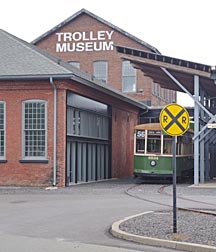 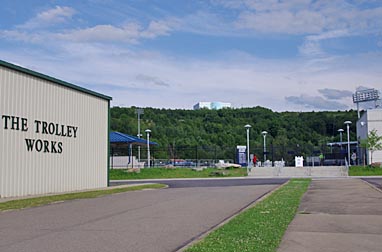 |
| Steam locomotives and trolleys play a large role in the history of the area. You can even ride a trolley from the Electric City Trolley Museum (above left) in downtown Scranton to The Trolley Works station right by the left-field gates of PNC Field (above right). |
No, this isn’t an example of mass transit providing access to the ballpark, because the ride times don’t coincide with baseball games except on certain designated weekend games. But it’s a fun excursion nonetheless.
The vast majority of fans come to games in cars, and PNC Field is easily accessible from Interstate 81. Take exit 182, and turn right onto Montage Mountain Road. In half a mile, you’ll see the ballpark’s parking lots on the left — just as you see a very strange sight on the right side of the road: The Bear Creek Ski Shack. Huh?
 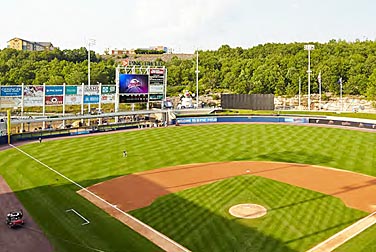 |
| Yes, snow skiing is right up the hill from PNC Field (well, in the wintertime). The photo on the right not only shows that the outfield concourse now runs all the way around the outfield, but you can also see some of the commercial buildings on the top of the hill. Photo on the right by Jeffrey Totaro, Courtesy of EwingCole |
That’s because if you continue on Montage Mountain Road, you’ll ascend up the mountain’s side until you reach the Toyota Pavilion, an amphitheater where major concerts and music festivals are held, and an area with ski slopes. Not a lot of ballparks have snow skiing in its neighborhood.
Also in PNC Field’s neighborhood is a commercial area with hotels, restaurants and shopping. In fact, you can see some of these buildings up on a plateau above the ballpark’s outfield. Even better, you can drive around to these businesses and walk over to the edge of the hill. There you’ll have a wonderful view of the ballpark below.
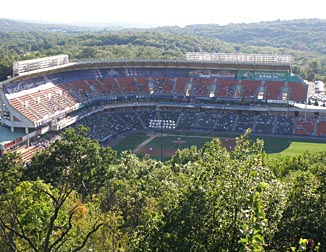 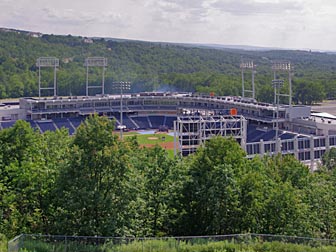 |
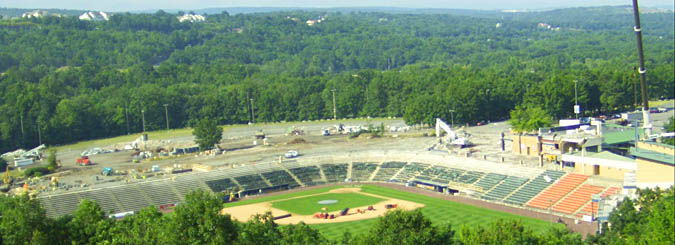 |
| Here’s before, during and after. In all three of these, the view of the ballpark is from the backyards of the restaurants and hotels up on Montage Mountain. The shot in the upper left is of the old park. Note how tall it is, and how the color scheme of the seats isn’t very appealing. The shot at the bottom was taken on July 5th of 2012, and it shows that almost all of the structures have been demolished, and the remaining seats are being removed. The low-profile new park is in the upper right. Bottom photo is by Lee A. Butz of Alvin H. Butz, Inc. |
Make no mistake about it: the most special element of this ballpark is the fact that it sits at the base of a mountain that rises 1,960 feet above sea level. Before the park was rebuilt, you could see the hillside, but you couldn’t really experience it. EwingCole’s fact sheet on the ballpark puts it very well: “Whereas the original ballpark design was sited ‘next to’ the mountain, the new design was built ‘into’ the mountain — the new wrap-around outfield concourse was literally sculpted into the base of the dramatic tree-covered mountain’s prominently exposed rock faces.”
Other teams with parks that feature hillsides just beyond the outfield include the Asheville Tourists and the Tennessee Smokies. Neither are as dramatic as this, nor do they allow fans to get next to the rocks and trees.